គោលដៅអភិវឌ្ឍប្រកបដោយចីរភាពទី៩ ផ្តោតលើការអភិវឌ្ឍហេដ្ឋារចនាសម្ព័ន្ធ និងឧស្សាហកម្មដែលមានចីរភាព និងភាពស៊ាំ រួមទាំងសហគ្រាសខ្នាតតូច។ គោលដៅនេះ ចូលរួមដល់ការស្រាវជ្រាវវិទ្យាសាស្ត្រ និងការធ្វើឱ្យប្រសើរឡើងនូវសមត្ថភាពបច្ចេកវិទ្យានៃឧស្សាហកម្ម។ លទ្ធភាពទទួលបាននូវបច្ចេកវិទ្យាគមនាគមន៍ និងព័ត៌មាន (ប.គ.ព) និងការប្រើប្រាស់អ៊ិនធឺណិតដែលមានតំលៃសមរម្យក៏ត្រូវបានរួមបញ្ចូលនៅក្នុងគោលដៅទី៩ នេះដែរ។ គោលដៅនេះ មានចំណុចដៅទូទៅចំនួន៥ និងចំណុចដៅនៃមធ្យោបាយទិសដៅអនុវត្តចំនួន៣។ គោលដៅអភិវឌ្ឍប្រកបដោយចីរភាពទី៩ មានសូចនាករចំនួន១២។
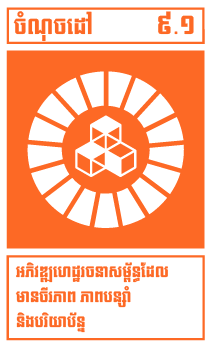 |  | 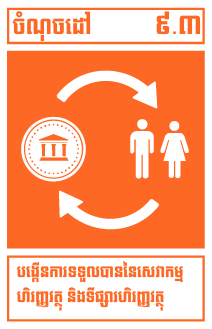 | 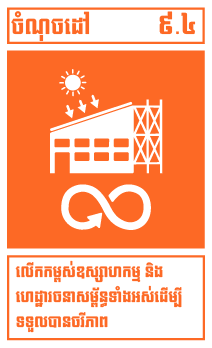 |
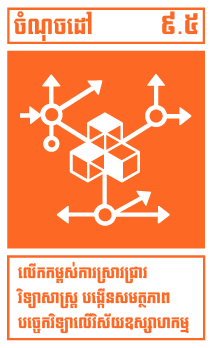 | 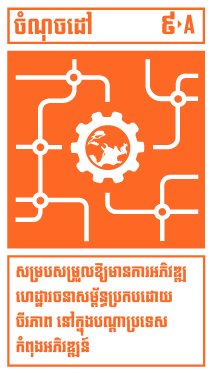 | 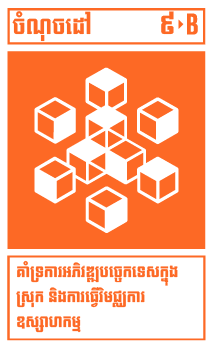 | 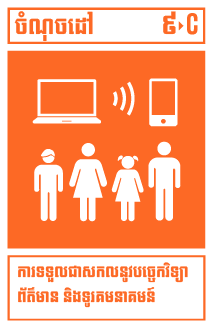 |
ការផ្លាស់ប្តូរពីគោលដៅអភិវឌ្ឍន៍សហស្សវត្សរ៍ ទៅកាន់គោលដៅអភិវឌ្ឍប្រកបដោយចីរភាពទី៩ នៅក្នុងប្រទេសកម្ពុជា
គ្មានចំណុចដៅណាមួយនៃគោលដៅអភិវឌ្ឍន៍សហសវត្សរ៍មុនៗ មានលក្ខណៈស្រដៀងគ្នាទៅនឹងចំណុចដៅរបស់គោលដៅអភិវឌ្ឍប្រកបដោយចីរភាពកម្ពុជាទី៩ ដែលពាក់ព័ន្ធជុំវិញនឹងហេដ្ឋារចនាសម្ព័ន្ធ ឬឧស្សាហូបនីយកម្មឡើយ។ គោលដៅអភិវឌ្ឍប្រកបដោយចីរភាពកម្ពុជាទី៩ មានលក្ខណៈថ្មីទាំងស្រុង ជាជាងធ្វើការដើម្បីសម្រេចនូវចំណុចរបស់គោលដៅអភិវឌ្ឍន៍សហសវត្សរ៍មុនៗ ឬសកម្មភាពណាដែលមិនទាន់បានសម្រេច។
គោលដៅដែលបានធ្វើមូលដ្ឋានីយកម្មរួចហើយ គឺគោលដៅអភិវឌ្ឍប្រកបដោយចីរភាពកម្ពុជាទី៩ ដែលមានគោលបំណងធ្វើឱ្យឧស្សាហកម្មនៅកម្ពុជាមានភាពរីកចម្រើន និងជឿនលឿនទៅមុខ។ ចក្ខុវិស័យក្នុងការផ្លាស់ប្តូរនិងធ្វើទំនើបកម្មវិស័យឧស្សាហកម្ម ពីឧស្សាហកម្មដែលពឹងផ្អែកលើកម្លាំងពលកម្មខ្លាំង ទៅជាឧស្សាហកម្មដែលជំរុញដោយជំនាញនៅឆ្នាំ២០២៥ មានលម្អិតនៅក្នុងផែនការអភិវឌ្ឍន៍ឧស្សាហកម្ម (IDP) របស់រាជរដ្ឋាភិបាលកម្ពុជា។ រាជរដ្ឋាភិបាលកម្ពុជាបានដាក់ចេញនូវយុទ្ធសាស្ត្រ ដើម្បីដឹកនាំប្រទេសកម្ពុជាចូលទៅក្នុងសេដ្ឋកិច្ចមានប្រាក់ចំណូលមធ្យមនៅឆ្នាំ២០៣០ និងប្រទេសដែលមានប្រាក់ចំណូលខ្ពស់នៅឆ្នាំ២០៥០ តាមរយៈផែនការយុទ្ធសាស្ត្រអភិវឌ្ឍន៍ជាតិ។ កត្តាជំរុញដល់ការរីកចម្រើននាពេលអនាគត គឺតួនាទីរបស់ឧស្សាហកម្ម និងសហគ្រាសធុនតូច និងមធ្យម។1 ចក្ខុវិស័យនេះសម្លឹងទៅការផ្សាភ្ជាប់ដោយជោគជ័យពីថ្នាក់តំបន់ទៅនឹងខ្សែសចង្វាក់តម្លៃសកល ដែលនឹងបង្កើតចង្កោមក្រុមផលិតកម្មដែលមានទាក់ទងគ្នារួមគ្នាក៏ដូចជាការរួមបញ្ចូលគ្នានូវផលិតកម្មក្នុងតំបន់ទៅក្នុងបណ្តាញអន្តរជាតិ។ ជោគជ័យនៃគោលដៅនេះនឹងរួមចំណែកដល់ការអភិវឌ្ឍសេដ្ឋកិច្ចជាតិ កំណើនសេដ្ឋកិច្ចខ្ពស់ដែលប្រកបដោយនិរន្តរភាព និងរាប់បញ្ចូលទាំងការបង្កើតការងារ ការបង្កើនតម្លៃបន្ថែមទៅលើសេដ្ឋកិច្ច និងបង្កើនប្រាក់ចំណូលសម្រាប់ប្រជាជនកម្ពុជា។2 ធនាគារពិភពលោកបានរកឃើញនៅក្នុងរបាយការណ៍មួយក្នុងខែឧសភាឆ្នាំ ២០១៩ថា សេដ្ឋកិច្ចកម្ពុជាដំណើរការបានល្អប្រសើរជាងការរំពឹងទុកក្នុងនៅក្នុងឆ្នាំ ២០១៨។កំណើនសេដ្ឋកិច្ចសម្រាប់ឆ្នាំ ២០១៨ មាន ៧.៥ ភាគរយ ជាអត្រាខ្ពស់ក្នុងរយៈពេល ៤ ឆ្នាំ បើប្រៀបធៀបនឹងឆ្នាំ ២០១៧ មាន ៧ ភាគរយ។ កំណើនសេដ្ឋកិច្ចនេះ ជាកំណើនខ្ពស់បំផុតនៅក្នុងតំបន់ ដែលភាគច្រើនបានមកពីការពង្រីកយ៉ាងឆាប់រហ័សនៃការនាំចេញ និងការកើនឡើងនៃការវិនិយោគដោយផ្ទាល់ពីបរទេស (FDI)។3
ផលិតកម្ម
ឧស្សាហកម្មកម្ពុជានៅតែទន់ខ្សោយ ដោយសារមានមូលដ្ឋានតូចចង្អៀត កម្រិតទាបនៃបច្ចេកវិទ្យាទំនើប ការបែងចែកតម្លៃទាប និងការផ្តោតលើតែវិស័យមួយចំនួន ដូចជាកាត់ដេរ និងការកែច្នៃម្ហូបអាហារ។ វិស័យបង្គុំផលិតកម្មធុនស្រាលរបស់កម្ពុជា មានទីតាំងខ្លះស្ថិតនៅក្នុងតំបន់សេដ្ឋកិច្ចពិសេស តែមួយភាគធំមិនស្ថិតនៅក្នុងតំបន់សេដ្ឋកិច្ចពិសេសនោះឡើយ ដែលជាហេតុធ្វើឱ្យប្រតិបត្តិការពឹងផ្អែកយ៉ាងខ្លាំងលើកម្លាំងពលកម្ម។ ការផលិតសម្ភារៈសំណង់ អេឡិចត្រូនិច គ្រឿងចក្រ គ្រឿងម៉ាស៊ីន និងផលិតផលគីមី នៅតែមានទំហំតូចនៅឡើយ។4 វិស័យផលិតកម្មមានចំនួន ៣១% នៃសេដ្ឋកិច្ចកម្ពុជាក្នុងឆ្នាំ ២០១៦។5 អត្រាកំណើនរបស់កម្ពុជាសម្រាប់តម្លៃបន្ថែមនៅក្នុងឧស្សាហកម្ម គឺខ្ពស់បំផុតនៅអាស៊ីអាគ្នេយ៍។6 ធនាគារអភិវឌ្ឍន៍អាស៊ីបានព្យាករណ៍ថា ផលិតកម្មរបស់កម្ពុជានឹងបន្តកើនឡើងប្រមាណ ៩.៦% ជាមួយនឹងការធ្លាក់ចុះវិស័យសម្លៀកបំពាក់ និងស្បែកជើងដែលត្រូវបានកំណត់ដោយកំណើនខ្លាំងនៅក្នុងឧស្សាហកម្ម ដែលកំពុងរីកចម្រើនដូចជាផ្នែកអគ្គិសនី គ្រឿងបន្លាស់រថយន្ត កង់ រោងកិនស្រូវ និងកៅស៊ូ។7 នៅឆ្នាំ ២០១៧ ប្រទេសកម្ពុជាបានក្លាយជាអ្នកផ្គត់ផ្គង់កង់លេខ ១ របស់សហភាពអឺរ៉ុប។8
មានរោងចក្រចំនួន ១.៥២៨ នៅក្នុងប្រទេសកម្ពុជា នៅចុងឆ្នាំ២០១៨ នេះបើយោងតាមតួលេខរបស់ក្រសួងឧស្សាហកម្ម និងសិប្បកម្ម ហើយក្នុងនោះ មានចំនួន ៩២២ ដែលស្ទើរតែ ២ ភាគ ៣ ប្រតិបត្តិការជារោងចក្រត្បាញ កាបូប សម្លៀកបំពាក់ និងស្បែកជើង។9 ក្នុងឆ្នាំ២០១៨ ឃើញថាមានរោងចក្រថ្មីចំនួន ១៧៨ បានបើកទ្វារ បើប្រៀបធៀបទៅនឹងឆ្នា២០១៧ មានចំនួនត្រឹមតែ ១៥០។ ប្រាក់ចំណូលសរុបពីផលិតកម្មទាំងផលិតផលក្នុងស្រុក និងការនាំចេញមានប្រហែល ១៣,១៧ ពាន់លានដុល្លារអាមេរិកក្នុងឆ្នាំ២០១៨ ពោលគឺកើនឡើង ២៣% ធៀបនឹងឆ្នាំ២០១៧។ ជាង ៦៣% នៃសហគ្រាសផលិតកម្មធំៗ កំពុងស្ថិតក្នុងទម្រង់នៃការវិនិយោគផ្ទាល់ពីបរទេស និងការនាំចេញ។ សហគ្រាសផលិតកម្មធំៗ ចំនួន ៦៨ ភាគរយមានទីតាំងនៅរាជធានីភ្នំពេញ និង ១៣ ភាគរយនៅខេត្តកណ្តាល។10
ការវិនិយោគដោយរាជរដ្ឋាភិបាលកម្ពុជា ដៃគូអភិវឌ្ឍន៍ និងវិស័យឯកជនបានបន្តកំណត់ទិសដៅហេដ្ឋារចនាសម្ព័ន្ធដូចជាផ្លូវថ្នល់ ផ្លូវដែក ស្ពាន កំពង់ផែ វារីអគ្គិសនី កសិដ្ឋានថាមពលពន្លឺព្រះអាទិត្យ បណ្តាញបញ្ជូនថាមពលនិងប្រព័ន្ធធារាសាស្ត្រ។ នេះបានជួយរោងចក្រកាត់ដេរផ្លាស់ប្តូរពីរាជធានីទៅតំបន់ជនបទ ដែលអាចឱ្យកម្មករធ្វើការនៅជិតផ្ទះ និងកាត់បន្ថយការកកស្ទះ និងបន្ទុកលើហេដ្ឋារចនាសម្ព័ន្ធនៅក្នុងទីក្រុង។ វិស័យកាត់ដេរបានផ្តល់ការងារដល់កម្មករប្រមាណ ៦៣៥.០០០ នាក់ក្នុងឆ្នាំ២០១៧ ដែលរោងចក្រមានចំនួន ៦៤៣។11 ប្រហែល ៩០ ភាគរយនៃកម្លាំងពលកម្ម គឺជាស្ត្រី។12 ការនាំចេញមានចំនួនសរុប ៨,០២ ពាន់លានដុល្លារក្នុងឆ្នាំ២០១៧ (កើនឡើង ៩,៥% ពីឆ្នាំ២០១៦) និងស្មើនឹង ៧២% នៃការនាំចេញទំនិញសរុបរបស់កម្ពុជា។13 ការនាំចេញស្បែកជើងបានកើនឡើង ១៤,៤% ពីមួយឆ្នាំទៅមួយឆ្នាំ រហូតដល់ ៨៧៣ លានដុល្លារនៅក្នុងឆ្នាំ២០១៧ នេះ។
លើសពីសម្លៀកបំពាក់ និងស្បែកជើង
មានឱកាសជាច្រើនកកើតសម្រាប់ឧស្សាហកម្មជាតិផ្សេងទៀត។ ការធ្វើពិពិធកម្មមូលដ្ឋានឧស្សាហកម្មឆ្ងាយពីរោងចក្រកាត់ដេរដែលមានជំនាញទាប និងការកែច្នៃម្ហូបអាហារ គឺមានភាពចាំបាច់សម្រាប់ការរីកចម្រើន និងការអភិវឌ្ឍជាបន្តបន្ទាប់ទៅក្នុងបច្ចេកវិទ្យាខ្ពស់។ រដ្ឋាភិបាលបានរៀបចំ និងអនុម័តគោលនយោបាយអភិវឌ្ឍឧស្សាហកម្ម នៅខែមីនា ឆ្នាំ២០១៥ ដែលដើរតួជាមគ្គុទេសក៍ ផ្ដល់នូវដំណោះស្រាយជាប្រព័ន្ធក្នុងការអភិវឌ្ឍវិស័យឧស្សាហកម្មដែលមានការប្រកួតប្រជែងនៅក្នុងប្រទេសកម្ពុជា។14 គោលដៅសំខាន់នៃគោលនយោបាយអភិវឌ្ឍឧស្សាហកម្ម គឺជំរុញការធ្វើពិពិធកម្មសេដ្ឋកិច្ចក្រៅពីការផលិតសម្លៀកបំពាក់ និងស្បែកជើង។ គោលដៅ គឺដើម្បីឱ្យផលិតផលលេចធ្លោទាំងនេះធ្លាក់ចុះដល់ ៥៥ ភាគរយនៃការនាំចេញសរុបនៅឆ្នាំ២០២០ និង ៥០ ភាគរយនៅឆ្នាំ២០២៥។15
ការធ្វើមូលដ្ឋានីយកម្មរបស់ គោលដៅទី ៩ នៅក្នុងប្រទេសកម្ពុជា
គោលដៅអភិវឌ្ឍន៍យុទ្ធសាស្ត្រកម្ពុជាទី ៩ លើកយកចំណុចដៅ ៥ ក្នុងចំណោម ៨ គោលដៅ និង ៧ ក្នុងចំណោមសូចនាករទាំង ១២ ចេញពីគោលដៅរបស់ពិភពលោក (តារាងទី ១)។
តារាងទី១៖ គោលដៅ និងសូចនាករនៃ គ.អ.ច.ក ៩16
ចំណុចដៅនៃ គ.អ.ច.ក | សូចនាករនៃ គ.អ.ច.ក | ឯកតា | ឆ្នាំគោល(២០១៥) | ២០២០ | ២០២៥ | ២០៣០ | រយៈពេលត្រួតពិនិត្យ |
៩.១ អភិវឌ្ឍហេដ្ឋារចនាសម្ព័ន្ធដែលមានគុណភាព អាចជឿជាក់បានធន់នឹងការប្រែប្រួលអាកាសធាតុ និងចីរភាព រួមទាំង ហេដ្ឋារចនាសម្ព័ន្ធតំបន់ និងឆ្លងកាត់ព្រំដែនប្រទេស ដើម្បីគាំទ្រដល់ការអភិវឌ្ឍសេដ្ឋកិច្ច និងលើកកម្ពស់កម្រិតជីវភាពរស់នៅរបស់ប្រជាជន ជាមួយនឹងការផ្ដោតការយកចិត្តទុកដាក់លើការទទួលបានដោយសមរម្យ និងសមធម៌សម្រាប់ប្រជាជនគ្រប់រូប | ៩.១.១ បរិមាណទំនិញឆ្លងកាត់ផែប្រចាំឆ្នាំ |
|
|
|
|
| រៀងរាល់ឆ្នាំ |
កំពង់ផែស្វយ័តក្រុងព្រះសីហនុ | ពាន់តោន |
| ៤ ៩៧១ |
|
|
| |
កំពង់ផែស្វយ័តភ្នំពេញ | ពាន់តោន |
| ២ ៩៣០ |
|
|
| |
៩.១.២ ចំនួនអ្នកដំណើរតាមអាកាស (ក្នុងស្រុក និងអន្តរជាតិ) | នាក់ | ៦ ០៤២ ៤៨៤ | ៥៩ ៨៤២ ១៨១ | ១៦ ២៥០ ១៩០ | ២៦ ៩៦៩ ៦៣៣ | រៀងរាល់ឆ្នាំ | |
ផ្លូវអាកាសក្នុងស្រុក | នាក់ | ៤៣៦ ១៦៧ | ៤៦១ ៩៩២ | ៥១៥ ០៩៧ | ៥៧៤ ៣០៦ |
| |
ផ្លូវអាកាសអន្តរជាតិ | នាក់ | ៥ ៦០៦ ៣១៧ | ៩ ៣៨០ ១៨៩ | ១៥ ៧៣៥ ០៩៣ | ២៦ ៣៩៥ ៣២៧ |
| |
៩.១.៣ បរិមាណទំនិញដឹកជញ្ជូន (ក្នុងស្រុក និងអន្តរជាតិ) | តោន | ៣៧ ១៥០ | ៨៤ ៨០៣ | ១៨០ ២៩១ | ៣៨៣ ៥២៦ | រៀងរាល់ឆ្នាំ | |
បរិមាណទំនិញដឺកជញ្ជូនក្នុងស្រុក | តោន | ២៥២ | ៨៦ | ៤១ | ២០ |
| |
បរិមាណទំនិញដឺកជញ្ជូនចេញចូលក្នុងប្រទេស | តោន | ៣៦ ៨៩៨ | ៨៤ ៧១៨ | ១៨០ ២៤៩ | ៣៨៣ ៥០៦ |
| |
៩.២ លើកកម្ពស់ឧស្សាហូបនីយកម្មប្រកបដោយបរិយាបន្ន និងចីរភាព និងត្រឹមឆ្នាំ២០៣០ បង្កើនឱ្យបានច្រើន ឧស្សាហកម្មដែលរួមចំណែកបង្កើតការងារ និងផលិតផលក្នុងស្រុកសរុបឱ្យស្របតាមកាលៈទេសៈជាតិ និងបង្កើនការរួមចំណែកនេះទ្វេដង នៅក្នុងបណ្ដាប្រទេសដែលមានការអភិវឌ្ឍតិចតួច។ | ៩.២.១ សមាមាត្រនៃចំនួននិយោជិតកម្ពុជាក្នុងវិស័យ សហគ្រាសកម្មន្ដសាល ធៀបនឹងចំនួនការងារសរុបក្នុងប្រទេស។ | % | ១០ (២០១៦) | ១៥ | ២០ | ២៥ | រៀងរាល់ឆ្នាំ |
៩.៥ លើកកម្ពស់ការស្រាវជ្រាវវិទ្យាសាស្ត្រ បង្កើនសមត្ថភាពបច្ចេកវិទ្យារបស់វិស័យឧស្សាហកម្មនៅគ្រប់ប្រទេស ជាពិសេស បណ្ដាប្រទេសកំពុងអភិវឌ្ឍក្នុងនោះត្រឹមឆ្នាំ២០៣០ លើកទឹកចិត្តនវានុវត្តន៍ និងបង្កើនចំនួននៃពលករ ស្រាវជ្រាវ និងការអភិវឌ្ឍក្នុងប្រជាជន១លាននាក់ និងការចំណាយដល់ការស្រាវជ្រាវ និងការអភិវឌ្ឍផ្នែកសាធារណៈ និងឯកជន | ៩.៥.១ សមាមាត្រនៃចំណាយលើការស្រាវជ្រាវ និងអភិវឌ្ឍធៀបនឹងផលិតផលក្នុងស្រុកសរុប | % | ០,១២ (២០១៦) | ០,២០ | ១,០០ |
| ៥ ឆ្នាំ |
៩.a សម្របសម្រួលឱ្យមានការអភិវឌ្ឍហេដ្ឋារចនាសម្ព័ន្ធ ដែលមានភាពបន្ស៊ាំ និងប្រកបដោយចីរភាព នៅក្នុងបណ្ដាប្រទេសកំពុងអភិវឌ្ឍតាមរយៈការលើកកម្ពស់ការគាំទ្រហិរញ្ញវត្ថុ បច្ចេកវិទ្យា និងបច្ចេកទេសដល់បណ្ដាប្រទេសនៅទ្វីបអាហ្វ្រិក បណ្ដាប្រទេសដែលមានការអភិវឌ្ឍតិចតួច បណ្ដាប្រទេសដែលពុំមានព្រំដែនជាប់សមុទ្រកំពុងអភិវឌ្ឍ និងបណ្ដារដ្ឋដែនកោះតូចៗកំពុងអភិវឌ្ឍ។ | ៩.a.១ ការគាំទ្រផ្លូវការសរុបពីអន្តរជាតិ (ជំនួយអភិវឌ្ឍន៍ផ្លូវការ និងលំហូរផ្លូវការផ្សេងទៀត) ដល់ការកសាង និងជួសជុលហេដ្ឋារចនាសម្ព័ន្ធ | %នៃផ.ស.ស. | ១,៦៥ (២០១៦) | ១,២៥ | ០,៩១ | ០,៦៨ | រៀងរាល់ឆ្នាំ |
៩.c បង្កើនឱ្យបានច្រើនការទទួលបានបច្ចេកវិទ្យាព័ត៌មាន និងទូរគមនាគមន៍ និងខិតខំប្រឹងប្រែង ផ្ដល់នូវការទទួលបានឱ្យបានសមរម្យ និងជាសកលនូវសេវាអ៊ិនធើណែតនៅប្រទេសកម្ពុជា ត្រឹមឆ្នាំ២០២០ | ៩.c.១ សមាមាត្រនៃប្រជាជនប្រើប្រាស់បណ្ដាញអ៊ិនធើណែត (ចល័ត និងអចល័ត) | % | ១៣៥,៣៥ | ១២២,៩០ | ១២៩,១៧ | ១៣៥,៧៦ | រៀងរាល់ឆ្នាំ |
ការបិទគម្លាតលើការងារផ្លូវការ និងក្រៅផ្លូវការ គឺជាមុខងារសំខាន់មួយទៀត។ សហគ្រាសក្រៅផ្លូវការចាំបាច់ត្រូវធ្វើអាជីវកម្មជាផ្លូវការ។ ការបង្កើត និងពង្រឹងវប្បធម៌សហគ្រិនភាពដែលឃ្លាតឆ្ងាយពីបច្ចេកវិទ្យាដែលមានតម្លៃបន្ថែម និងកម្រិតទាប គឺជាអ្វីដែលគោលនយោបាយឧស្សាហកម្មមើលឃើញ។ សហគ្រាសក្រៅផ្លូវការភាគច្រើនមានលក្ខណៈគ្រួសារ និងមិនអាចធ្វើការផ្លាស់ប្តូរដែលចាំបាច់ និងសម្រេចបាននូវប្រភេទនៃការកសាងសមត្ថភាពចាំបាច់ដើម្បីចូលរួមក្នុងទីផ្សារអន្តរជាតិ។17
ប្រទេសកម្ពុជាបានបន្តទទួលការវិនិយោគផ្ទាល់ពីបរទេសយ៉ាងច្រើន ដោយផ្តោតជាសំខាន់លើការអភិវឌ្ឍអចលនទ្រព្យ និងទេសចរណ៍ក្នុងរយៈពេលប៉ុន្មានឆ្នាំចុងក្រោយនេះ។18 កំណើននៃវិស័យទេសចរណ៍ និងការវិនិយោគរបស់ចិនកំពុងជះឥទ្ធិពលយ៉ាងខ្លាំងដល់ខេត្តព្រះសីហនុ និងតំបន់ឆ្នេរសមុទ្រទាំងអស់របស់កម្ពុជា។ មានសេចក្តីរាយការណ៍ថា គិតត្រឹមតែសប្តាហ៍ដំបូងនៃខែវិច្ឆិកា ឆ្នាំ២០១៨ ក្រុមប្រឹក្សាអភិវឌ្ឍន៍កម្ពុជាបានអនុម័តគម្រោងសណ្ឋាគារលំដាប់ផ្កាយ៥ ចំនួន៥ ដែលមានបន្ទប់សរុបចំនួន៣ ០០០។19
ធនាគារពិភពលោកបានបញ្ជាក់កាលពីខែតុលា ឆ្នាំ ២០១៧ ថា វិស័យទេសចរណ៍បានចូលរួមចំណែក ២៨,៣ ភាគរយនៃ ផ.ស.ស របស់កម្ពុជា និង ២៥.៩ ភាគរយនៃការងារ។20 យោងតាមក្រសួងទេសចរណ៍ចំនួនភ្ញៀវទេសចរណ៍ក្នុងស្រុកក្នុងរយៈពេលជាង១០ឆ្នាំ បានកើនឡើងទ្វេដងក្នុងឆ្នាំ២០១៦ ដែលមានចំនួនប្រមាណ១០លាននាក់។21 ក្នុងអំឡុងពេលមួយទសវត្សរ៍នេះ សញ្ជាតិរបស់ជនបរទេសដែលមកទស្សនាប្រទេសកម្ពុជាបានផ្លាស់ប្តូរយ៉ាងខ្លាំង។ ខណៈពេលដែលបណ្តាប្រទេសលោកខាងលិច គឺជាទីផ្សារកំពូលសម្រាប់ទេសចរណ៍បរទេសនៅដើមទសវត្សឆ្នាំ២០០០ ចំនួននេះ កំពុងត្រូវបានគ្របដណ្ដប់ដោយភ្ញៀវទេសចរមកពីប្រទេសចិន វៀតណាម និងប្រទេសអាស៊ីដទៃទៀត។ ភ្ញៀវទេសចរចិនជាង ១,២ លាននាក់បានមកដល់ក្នុងឆ្នាំ២០១៧ ដែលកើនឡើង ៤៦% បើធៀបនឹងឆ្នាំមុន។22 ភ្ញៀវទេសចរអន្តរជាតិចំនួន ៣ ភាគ ៤ សព្វថ្ងៃនេះមកពីតំបន់អាស៊ី/ប៉ាស៊ីហ្វិក ហើយមានត្រឹមតែ ១៥ ភាគរយប៉ុណ្ណោះដែលមកពីអឺរ៉ុប។23
កង្វះការតភ្ជាប់នៅតំបន់ជនបទ
សមាមាត្រនៃចំនួនប្រជាជនដែលមានអ៊ិនធឺរណែតប្រើប្រាស់ ជាពិសេសតាមរយៈទូរស័ព្ទចល័តបានកើនឡើងគួរឱ្យកត់សម្គាល់ក្នុងរយៈពេលប៉ុន្មានឆ្នាំចុងក្រោយនេះ ជាពិសេសនៅតំបន់ជនបទ ដោយសារហេដ្ឋារចនាសម្ព័ន្ធទូរគមនាគមន៍ត្រូវបានពង្រីកយ៉ាងឆាប់រហ័ស។ នៅតំបន់ជនបទភាគច្រើន ប្រជាជនអាចប្រើសេវា 3G ឬ 4G នៅលើទូរស័ព្ទឆ្លាតវៃរបស់ពួកគេ។ រាជរដ្ឋាភិបាលកម្ពុជាបានជំរុញការតភ្ជាប់ខ្សែកាបអុបទិក ដោយបានកើនឡើងដល់ ៤៣,៤១០ គីឡូម៉ែត្រក្នុងឆ្នាំ២០១៨ រួមជាមួយបណ្តាញខ្សែកាបអុបទិកក្រោមសមុទ្រចំនួន ២។ ការប្រើប្រាស់បច្ចេកវិទ្យាគមនាគមន៍ និងព័ត៌មាន (ប.គ.ព) បានកើនឡើងគួរឱ្យកត់សម្គាល់ ដូចដែលបានឆ្លុះបញ្ចាំងពីការកើនឡើងនៃអ្នកប្រើប្រាស់ទូរស័ព្ទចល័តពី ២,៧ លាននាក់ក្នុងឆ្នាំ២០១២ ដល់ ១១ លាននាក់នៅឆ្នាំ២០១៨។24 វិស័យឯកជននឹងវិនិយោគលើហេដ្ឋារចនាសម្ព័ន្ធ និងសេវាកម្ម ICT ដែលមានអាចធ្វើជំនួញរឹងមាំ ហើយរកប្រាក់ចំណេញបាន។ ទោះជាយ៉ាងណាក៏ដោយ តំបន់ដែលមានសមត្ថភាពខ្វះខាតភាគច្រើនគឺនៅតំបន់ជនបទ និងតំបន់ដាច់ស្រយាល ជាពិសេសការប្រើអ៊ិនធឺណិតល្បឿនលឿន។25
ក្នុងករណីបែបនេះ រាជរដ្ឋាភិបាលកម្ពុជានឹងដាក់ពង្រាយគោលនយោបាយ និងក្របខណ្ឌគតិយុត្តិដើម្បីធានាបាននូវលទ្ធភាព និងការតភ្ជាប់ដែលមានតំលៃសមរម្យ។ ជាពិសេស អនុក្រឹត្យស្តីពីយន្តការនៃការអនុវត្តកាតព្វកិច្ចសេវាកម្មជាសកលដែលបានចេញនៅឆ្នាំ២០១៧ ត្រូវបានគេចាត់ទុកថាជាឧបករណ៍ដ៏សំខាន់មួយក្នុងការជំរុញការតភ្ជាប់ទៅគ្រប់ទិសទីនៃប្រទេស។ នេះពាក់ព័ន្ធនឹងយន្តការសកលសម្រាប់ការបង្រួមគម្លាតការបែងចែកឌីជីថល ជាពិសេសនៅក្នុងតំបន់ដែលមិនមានសក្តានុពលខាងសេដ្ឋកិច្ច ក្នុងការកសាងហេដ្ឋារចនាសម្ព័ន្ធទូរគមនាគមន៍ ឬតំបន់ដែលវិស័យឯកជនមិនមានការចាប់អារម្មណ៍។ វាមានគោលបំណងផ្តល់នូវលទ្ធភាពប្រើប្រាស់ឌីជីថលជាសកល។26
ចំណុចរបត់សម្រាប់សហគ្រាសធុនតូច និងមធ្យម
- ប្រទេសកម្ពុជានៅតែប្រឈមនឹងបញ្ហាប្រឈមជាច្រើនរួមមាន៖
- ថ្លៃដើមនៃការដឹកជញ្ជូនខ្ពស់
- ការសម្របសម្រួលរវាងស្ថាប័នមានភាពខ្សោយ
- កង្វះហេដ្ឋារចនាសម្ព័ន្ធដែលមានគុណភាពដូចគ្នា ដែលកំណត់លទ្ធភាពនៃការចូលទៅកាន់ទីផ្សាររបស់អ្នកផលិត និងជម្រើសរបស់សហគ្រាសនៅទូទាំងប្រទេស
- កង្វះនៃការអភិវឌ្ឍថាមពល ការអភិវឌ្ឍជំនាញ និងបច្ចេកវិទ្យា រួមទាំងបច្ចេកវិទ្យាឌីជីថល ដែលរារាំងកំណើននៃអនុវិស័យផលិតកម្ម
- សមត្ថភាពមិនគ្រប់គ្រាន់ដើម្បីអនុវត្តគោលនយោបាយអភិវឌ្ឍន៍ឧស្សាហកម្ម27
នៅខែកក្កដា ឆ្នាំ២០១៧ ធនាគារពិភពលោកបានប្រកាសផ្តល់ថវិការចំនួន ៥៤០ លានដុល្លារអាមេរិកដល់ប្រទេសកម្ពុជា ក្នុងចន្លោះឆ្នាំ ២០១៨-២០២១ ដើម្បីផ្តល់ហិរញ្ញប្បទានដល់ការអភិវឌ្ឍសេដ្ឋកិច្ច ដោយផ្តោតជាពិសេសលើការគាំទ្រដល់ការអនុវត្តគោលនយោបាយអភិវឌ្ឍន៍ឧស្សាហកម្ម។28 កាលពីខែមីនា ឆ្នាំ២០១៩ នៅក្នុងវេទិកាវិស័យឯកជនរបស់រាជរដ្ឋាភិបាល លោកនាយករដ្ឋមន្រ្តីនៃកម្ពុជាបានបង្ហាញអំពីវិធានការណ៍កំណែទម្រង់ចំនួន ១៧ ដែលមានគោលបំណងដើម្បីលើកកម្ពស់ការប្រកួតប្រជែងរបស់ប្រទេសកម្ពុជា លើកកម្ពស់សហគ្រាសធុនតូច និងមធ្យម និងទាក់ទាញការវិនិយោគផ្ទាល់ពីបរទេស។ នេះរួមបញ្ចូលទាំងការផ្តោតលើការកាត់បន្ថយការចំណាយលើភ័ស្តុភារ ការកាត់បន្ថយពន្ធអគ្គិសនី ការកែលម្អច្បាប់ការងារ និងការបង្កើនលទ្ធភាពទទួលបានហិរញ្ញវត្ថុដល់សហគ្រាសធុនតូច និងមធ្យម។ សកម្មភាពទាំងអស់នេះធ្វើឡើងក្នុងគោលបំណងបង្កើតកំណើនឧស្សាហកម្ម។
ក្រសួងឧស្សាហកម្ម និងសិប្បកម្មបានធ្វើសេចក្តីព្រាងផែនការអភិវឌ្ឍសហគ្រាសធុនតូច និងមធ្យមរយៈពេល ៥ ឆ្នាំ ដែលរំពឹងថានឹងចាប់ផ្តើមនៅដើមឆ្នាំ២០២០ ដើម្បីធ្វើកំណែទម្រង់សហគ្រាសធុនតូចនិងមធ្យម។ ផែនការអភិវឌ្ឍសហគ្រាសធុនតូច និងមធ្យមរយៈពេល៥ឆ្នាំ នឹងប្រមូលផ្តុំសមាជិកអាស៊ាន និងធាតុនៃគោលនយោបាយអភិវឌ្ឍន៍ឧស្សាហកម្ម ដើម្បីបង្កើតវប្បធម៌សហគ្រាសខ្នាតមីក្រូ តូច និងមធ្យម ដែលមានលក្ខណៈប្រកួតប្រជែង និងច្នៃប្រឌិត តាមរយៈការអនុវត្តផែនការសកម្មភាពយុទ្ធសាស្ត្រស្តីពីការអភិវឌ្ឍសហគ្រាសធុនតូច និងមធ្យម។29
លើសពីនេះ មូលនិធិអភិវឌ្ឍន៍ជំនាញត្រូវបានបង្កើតឡើងក្នុងឆ្នាំ២០១៨ ដើម្បីផ្តោតលើវិស័យអាទិភាពចំនួន ៥ គឺផលិតកម្ម សំណង់ បច្ចេកវិទ្យាគមនាគមន៍ និងព័ត៌មាន អេឡិចត្រូនិក និងទេសចរណ៍ ក្នុងគោលបំណងផ្សារភ្ជាប់គម្លាតជំនាញក្នុងសេដ្ឋកិច្ចកម្ពុជា។ ក្នុងឆ្នាំដដែលនេះ រាជរដ្ឋាភិបាលកម្ពុជាបានចេញអនុក្រឹត្យផ្តល់ការលើកលែងពន្ធដល់សហគ្រាសធុនតូច និងមធ្យម រយៈពេល៥ឆ្នាំ។ ធនាគារសហគ្រាសធុនតូច និងមធ្យម មូលនិធិអភិវឌ្ឍន៍សហគ្រិនភាព និងមជ្ឈមណ្ឌលលើកកម្ពស់សហគ្រិនភាពត្រូវបានបង្កើតឡើងដោយក្រសួងសេដ្ឋកិច្ច និងហិរញ្ញវត្ថុ ហើយរំពឹងថានឹងដាក់ឱ្យដំណើរការនៅឆ្នាំ២០១៩។30
រាជរដ្ឋាភិបាលកម្ពុជាបានដាក់ចេញនូវគោលបំណងដូចខាងក្រោមសម្រាប់គ.អ.ស. ទី៩ ដែលនឹងត្រូវសម្រេចនៅឆ្នាំ២០៣០។31
- ជំរុញឧស្សាហូបនីយកម្មបញ្ចូល ដែលប្រកបដោយចីរភាព និងបរិយាបន្ន និងបង្កើនចំណែកឧស្សាហកម្ម និងការងារក្នុងស្រុក
- ពង្រឹងការស្រាវជ្រាវវិទ្យាសាស្ត្រ ធ្វើឱ្យប្រសើរឡើងនូវសមត្ថភាពបច្ចេកវិទ្យានៃវិស័យឧស្សាហកម្មដែលជំរុញនវានុវត្តន៍ និងបង្កើនចំនួនបុគ្គលិកស្រាវជ្រាវ និងអភិវឌ្ឍន៍ក្នុងមួយលាននាក់ និងការស្រាវជ្រាវសាធារណៈ និងឯកជន និងការចំណាយលើការអភិវឌ្ឍ។
- សម្របសម្រួលការអភិវឌ្ឍហេដ្ឋារចនាសម្ព័ន្ធប្រកបដោយចីរភាព និងភាពធន់ តាមរយៈការគាំទ្រផ្នែកហិរញ្ញវត្ថុ បច្ចេកវិទ្យា និងបច្ចេកទេស
- បង្កើនការទទួលបាននូវបច្ចេកវិទ្យា ទូរគមនាគមន៍ និងព័ត៌មាន (ICT) ហើយខិតខំផ្តល់នូវប្រព័ន្ធអ៊ិនធើណែតជាលក្ខណៈសកល និងមានតម្លៃសមរម្យ នៅត្រឹមឆ្នាំ២០២០
ប្រធានបទពាក់ព័ន្ធ
ឯកសារយោង
- 1. ក្រសួងផែនការ. “ផែនការយុទ្ធសាស្ត្រអភិវឌ្ឍន៍ជាតិឆ្នាំ ២០១៤-២០១៨”។ ចូលអានថ្ងៃទី ២០ ខែវិច្ឆិកា ឆ្នាំ២០១៩។
- 2. ទីស្តីការគណៈរដ្ឋមន្រ្តី. “គោលនយោបាយអភិវឌ្ឍន៍ឧស្សាហកម្មកម្ពុជា ២០១៥-២០២៥”។ អនុម័តថ្ងៃទី៦ ខែមិនា ឆ្នាំ២០១៥។ ចូលអានថ្ងៃទី២០ ខែវិច្ឆិកា ឆ្នាំ២០១៩។
- 3. ធនាគារពិភពលោក ២០១៩. “បច្ចុប្បន្នភាពសេដ្ឋកិច្ចកម្ពុជា ខែឧសភា ២០១៩”។ ចូលអានថ្ងៃទី២០ ខែវិច្ឆិកា ឆ្នាំ២០១៩។
- 4. “កម្ពុជាបច្ចុប្បន្នក្លាយជាអ្នកផ្គត់ផ្គង់ឈានមុខគេរបស់សហភាពអឺរ៉ុប“។ Bike Europe ចុះថ្ងៃទី២៥ ខែមិថុនា ឆ្នាំ២០១៨។ ចូលអានថ្ងៃទី២០ ខែវិច្ឆិកា ឆ្នាំ២០១៩។
- 5. ធនាគារអភិវឌ្ឍន៍អាស៊ី ២០១៨. “ទស្សនវិស័យអភិវឌ្ឍន៍អាស៊ីឆ្នាំ ២០១៨៖ តើបច្ចេកវិទ្យាជះឥទ្ធិពលដល់ការងារយ៉ាងដូចម្តេច?“។ ខែមេសា ឆ្នាំ២០១៨។ ចូលអានថ្ងៃទី២០ ខែវិច្ឆិកា ឆ្នាំ២០១៩។
- 6. ដូចឯកសារយោងខាងដើម។
- 7. ដូចឯកសារយោងខាងដើម។
- 8. “កម្ពុជាបច្ចុប្បន្នក្លាយជាអ្នកផ្គត់ផ្គង់ឈានមុខគេរបស់សហភាពអឺរ៉ុប”។ Bike Europe ចុះថ្ងៃទី២៥ ខែមិថុនា ឆ្នាំ២០១៨។ ចូលអានថ្ងៃទី២០ ខែវិច្ឆិកា ឆ្នាំ២០១៩។
- 9. ក្រសួងព័ត៌មាន ២០១៩. “ចំនួនរោងចក្រកាន់តែខ្ពស់នៅឆ្នាំ ២០១៨”, ចុះថ្ងៃទី១៧ ខែមករា ឆ្នាំ២០១៩។ ចូលអានថ្ងៃទី២០ ខែវិច្ឆិកា ឆ្នាំ២០១៩។
- 10. ទីស្តីការគណៈរដ្ឋមន្រ្តី. “គោលនយោបាយអភិវឌ្ឍន៍ឧស្សាហកម្មកម្ពុជា ២០១៥-២០២៥”។ អនុម័តថ្ងៃទី៦ ខែមិនា ឆ្នាំ២០១៥។ ចូលអានថ្ងៃទី២០ ខែវិច្ឆិកា ឆ្នាំ២០១៩។
- 11. ILO មិថុនា ២០១៨. “ ព្រឹត្តិប័ត្រវិស័យសម្លៀកបំពាក់និងស្បែកជើងកម្ពុជា លេខ ៧“។ ចូលអានថ្ងៃទី២០ ខែវិច្ឆិកា ឆ្នាំ២០១៩។
- 12. OECD ២០១៨. “សន្ទស្សន៍គោលនយោបាយSME ៖ អាស៊ាន ២០១៨“. ចូលអានថ្ងៃទី២០ វិច្ឆិកា ២០១៩។
- 13. ILO មិថុនា ២០១៨។
- 14. ទីស្តីការគណៈរដ្ឋមន្រ្តី. “គោលនយោបាយអភិវឌ្ឍន៍ឧស្សាហកម្មកម្ពុជា ២០១៥-២០២៥”។ អនុម័តថ្ងៃទី៦ ខែមិនា ឆ្នាំ២០១៥។ ចូលអានថ្ងៃទី២០ ខែវិច្ឆិកា ឆ្នាំ២០១៩។
- 15. ធនាគារពិភពលោក ២០១៨. “បច្ចុប្បន្នភាពសេដ្ឋកិច្ចកម្ពុជា – ការអភិវឌ្ឍសេដ្ឋកិច្ចនិងចក្ខុវិស័យថ្មីៗ”។ ចូលអានថ្ងៃទី២០ ខែវិច្ឆិកា ឆ្នាំ២០១៩។
- 16. រាជរដ្ឋាភិបាលកម្ពុជា ២០១៨. “ក្របខណ្ឌគោលដៅអភិវឌ្ឍន៍ប្រកបដោយចីរភាពកម្ពុជាឆ្នាំ ២០១៦-២០៣០”។ ចូលអានថ្ងៃទី២០ ខែវិច្ឆិកា ឆ្នាំ២០១៩។
- 17. ទីស្តីការគណៈរដ្ឋមន្រ្តី. “គោលនយោបាយអភិវឌ្ឍន៍ឧស្សាហកម្មកម្ពុជា ២០១៥-២០២៥”។ អនុម័តថ្ងៃទី៦ ខែមិនា ឆ្នាំ២០១៥។ ចូលអានថ្ងៃទី២០ ខែវិច្ឆិកា ឆ្នាំ២០១៩។
- 18. រាជរដ្ឋាភិបាលកម្ពុជា ២០១៩. “ការត្រួតពិនិត្យថ្នាក់ជាតិដោយស្ម័គ្រចិត្ត ២០១៩”។ ចូលអានថ្ងៃទី២០ ខែវិច្ឆិកា ឆ្នាំ២០១៩។
- 19. សំណង់និងអចលនទ្រព្យ ២០១៩. “ក្រុងព្រះសីហនុមើលឃើញការហូរចូលនៃការវិនិយោគសណ្ឋាគារលំដាប់ផ្កាយ ៥”។ ចូលអានថ្ងៃទី ២០ ខែវិច្ឆិកា ឆ្នាំ២០១៩។
- 20. ធនាគារពិភពលោន តុលា ២០១៧. “បច្ចុប្បន្នភាពសេដ្ឋកិច្ចនៃធនាគារពិភពលោកនៅអាស៊ីបូព៌ានិងប៉ាស៊ីហ្វិក ខែតុលាឆ្នាំ ២០១៧”។ ធនាគារពិភពលោក រដ្ឋធានីវ៉ាស៊ីតោន។ ចូលអានថ្ងៃទី២០ ខែវិច្ឆិកា ឆ្នាំ២០១៩។
- 21. ហង្ស សុគន្ធាa, ២០១៦. “ទេសចរណ៍ក្នុងស្រុកកើនឡើងជិតទ្វេដងក្នុងរយៈពេល ១០ ឆ្នាំ”។ កាសែតឌឹខេមបូឌាដេលី ចុះថ្ងៃទី២៩ ខែធ្នូ ឆ្នាំ២០១៦។
- 22. ធនាគារពិភពលោក ២០១៨. “បច្ចុប្បន្នភាពសេដ្ឋកិច្ចកម្ពុជា – ការអភិវឌ្ឍសេដ្ឋកិច្ចនិងចក្ខុវិស័យថ្មីៗ”។ ចូលអានថ្ងៃទី២០ ខែវិច្ឆិកា ឆ្នាំ២០១៩។
- 23. ដូចឯកសារយោងខាងដើម។
- 24. រាជរដ្ឋាភិបាលកម្ពុជា ២០១៨. “យុទ្ធសាស្ត្រចតុកោណដំណាក់កាលទី ៤”។ ចូលអានថ្ងៃទី២០ ខែវិច្ឆិកា ឆ្នាំ២០១៩។
- 25. រាជរដ្ឋាភិបាលកម្ពុជា ២០១៩. “ការត្រួតពិនិត្យថ្នាក់ជាតិដោយស្ម័គ្រចិត្ត ២០១៩”។ ចូលអានថ្ងៃទី២០ ខែវិច្ឆិកា ឆ្នាំ២០១៩។
- 26. ដូចឯកសារយោងខាងដើម។
- 27. ដូចឯកសារយោងខាងដើម។
- 28. ម៉ៃ គុណមករា ២០១៧. “ធនាគារពិភពលោកសន្យាផ្តល់ប្រាក់ ៥៤០ លានដុល្លារដល់កម្ពុជា”។ កាសែតខ្មែរថាមស៍ ចុះថ្ងៃទី២០ ខែកក្កដា ឆ្នាំ២០១៧។
- 29. រាជរដ្ឋាភិបាលកម្ពុជា ២០១៩. “ការត្រួតពិនិត្យថ្នាក់ជាតិដោយស្ម័គ្រចិត្ត ២០១៩”។ ចូលអានថ្ងៃទី២០ ខែវិច្ឆិកា ឆ្នាំ២០១៩។
- 30. ដូចឯកសារយោងខាងដើម។
- 31. រាជរដ្ឋាភិបាលកម្ពុជា ២០១៨. “ក្របខណ្ឌគោលដៅអភិវឌ្ឍន៍ប្រកបដោយចីរភាពកម្ពុជាឆ្នាំ ២០១៦-២០៣០”។ ចូលអានថ្ងៃទី២០ ខែវិច្ឆិកា ឆ្នាំ២០១៩។

